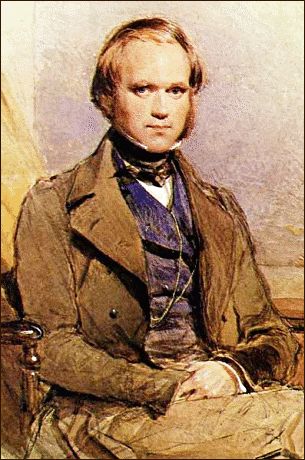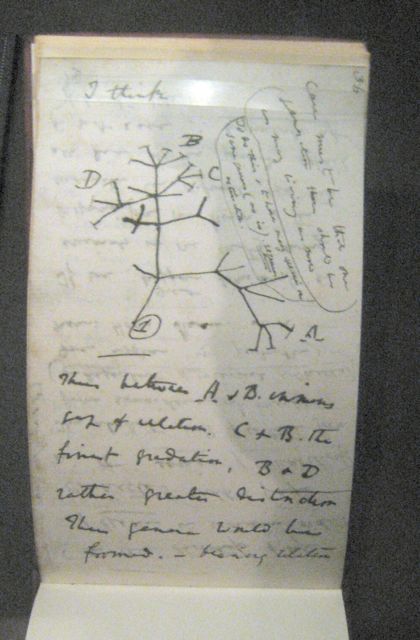This year is the 200th anniversary of the birth of Charles Darwin and his name and works connected with it are still familiar to us all. His theories are as controversial as they ever were, possibly more so. Religious fundamentalists see his writings as an attack on their own versions of how life came to be and 48% of Americans still don’t believe in evolution (Gallop poll 2007).
The objections put against his theories haven’t changed that much since he first published the Origin of Species back in 1859 and many of them arise from the same misinterpretation of Darwin’s words. Let’s take Leifchild’s review in the Athenaeum from November 19th 1859.
He initially claims that an intelligent man would reason:
Natural selection works solely by and for the good of each being, all corporeal and mental endowments will tend to progress towards perfection.
A misunderstanding which I’ve heard argued from religious objectors to the principle of evolution even today.
If a monkey has become a man, what may not a man become?
The last time I was talking about evolution, those very points came up, 150 years or so later. If we’ve been evolving all this time, why aren’t we perfect yet?
I’ll come back to that, but let’s continue with Leifchild’s objections. He goes on to say:
We might fairly expect to find in the fossiliferous rocks not a few proofs of the former existence of the numerous intermediate links between distinct specific forms if the proposed theory be true. We do not find them, many will allege, because they never existed….Palaeontology, however, has not yet revealed any such finely graduated organic scale, and it is not logical to assume that it ever will.
Which sounds very like the arguments of Harun Yahya (to pick a name at random) today:
If such animals had really existed, there would have been millions, even billions, of them. More importantly, the remains of these creatures should be present in the fossil record. The number of these transitional forms should have been even greater than that of present animal species, and their remains should be found all over the world
Leifchild’s not finished with fossils though:
There is positively hostile testimony from the rocks to be confronted. Whole groups of species suddenly and abruptly appear in certain formations and seem at once to contradict any theory of transmutation of species. Either than fact or the theory must be overturned.
Why aren’t there fish-birds, or short necked giraffes, or beaked reptiles we are asked?
Finally, he jumps in with the argument which basically sums up most of the objections of the American’s polled:
Why construct another elaborate theory to exclude Deity from renewed acts of creation? Why not at once admit that new species were introduced by the Creative energy of the Onmipotent. Why not accept direct interference, rather than evolutions of law, and needlessly indirect or remote action?
It seems to me that the arguments against Darwin’s theory haven’t changed that much in the last 150 years. However, this is where science has the advantage – we have the benefits of 150 years worth of experimentation, theorising, testing and confirmation to build on. We can accept criticisms and drawbacks to theories, even welcome them as harbingers of a more complete theory. Ok, so let’s turn that scientific juggernaut to bear – how much have we added to Darwin’s theory in the last 150 years?
Well, for starters, we’ve discovered a mechanism for evolution to work. The science of genetics has shown us how small changes in the pattern of our DNA and RNA can have large effects on our bodies and possibly even behaviours. We’ve also discovered how those traits can be passed on to our children and why features are generally distinct rather than blended. Darwin could only speculate. We’ve seen evolution in action as viruses acquire resistance to antibiotic strains. Darwin could only theorise based on evidence.
So, let’s see where we are with respect to the above criticisms.
Let’s start with the so-called ‘Cambrian Explosion’ and the gaps in the fossil record. It worried Darwin that the fossil record seems to indicate that virtually all major animal species appeared in a short interval at the beginning of the Cambrian period, starting around 530 million years ago, with fossils of the so-called major phyla (animals which share the same basic body plan, for want of a proper explanation) appearing in a period or around 5 to 10 million years after that (figures according to Gould).
However, recent studies are beginning to find evidence of pre-Cambrian ancestors for some species, pushing back their divergence point to before the ‘explosion’. In addition, not every evolutionary change will generate fossil evidence. Fossilisation isn’t going to preserve the soft-fleshy bits of any animal’s body so any evolutionary change which wasn’t affecting the hard body structure of creatures won’t be seen. It may also be that for much of the pre-Cambrian era there simply weren’t that many animals around, or those that were were scattered in small sparse geographically separate groups.
Simon Conway Morris of Cambridge University remarks:
Does this course of events create a problem for Darwinism, even for evolution? I do not think so. In particular, the search for any sort of trigger may be to misunderstand the problem. Rather than invoking an almost endless litany of possibilities, among which some of the more popular include the invention of a Hox gene, eyes, cell signalling, extracellular matrix, nerve cells, armour, guts and so on, it may be more useful to regard this event as the natural and inevitable result of the continuing evolution of a planetary system that shows cumulative and irreversible bio-geochemical changes. As and when the conditions are appropriate, the opportunism and flexibility of the evolutionary process will exert itself.
So, when new opportunities for life emerged in the Cambrian era, there was naturally an explosion of newly successful plans to exploit it.
Ok, but why don’t we see transitional animals in the fossil record? Where are the bird lizards and the short necked giraffes?
Here’s where we need to consider how new species are likely to evolve. Let’s take a group of lizards. Any mutations from the standard ‘lizard model’ are likely to be bred out as long as the mutated children remain in the group. Now let’s assume that our group becomes split into two, by say a mountain range or a river. Separated by a geological boundary it is likely that the two groups may evolve differently. Changes in one will not necessarily be represented by changes in the other and so, over a long period of time, they will differ enough to become separate species. We can see this in action with shrews today. Mongolian shrews cannot interbreed with Spanish shrews, even though there may be a continual chain of interbreeding shrews running between the two.
Now rejoin the groups. If you look at the fossil record for the original site it will appear than a new species has appeared practically overnight, with no intermediate changes visible
If the two ends of the chain then remerge, or the two groups of lizards span the river, then we will start to see jumps in the fossil record they leave behind, as if a new species has suddenly appeared, ready made. If one species out competes the other, you then see the other disappear, having been replaced. That doesn’t mean that they made a massive evolutionary jump, merely that they evolved seperately in another location.
We also need a feeling for the amount of time which can pass over the period which a paleontologist would consider instantaneous. The American geneticist Ledyard Stebbins considers the example of a mouse which gains an evolutionary advantage in each generation by being very slightly bigger. Ignoring any other factors, such as the cost of growing in size, how long would it take before the mouse became the size of an elephant? Picking a very small value for weight increase with each generation, so small that it wouldn’t be measurable by human observers, he calculated that it would take about 12,000 generations of mice before they reached elephantine sizes. If you assume each generation lasts 5 years, that’s a 60,000 year timespan to go from mouse to elephant. That period is too small to be measured by the standard techniques of dating the fossil record.
Our mouse to elephant jump would appear to be instantaneous.
The other objections are far easier to dismiss. Next on the list, “If man evolved from monkeys, why are there still monkeys and why aren’t we perfect yet?“. The first part is easy, man didn’t evolve from monkeys, we both share a common ancestor who wasn’t either. Both men and monkeys have evolved enough to propagate their genes onto their offspring in their own respective fields. Put a monkey in a city or a man with no equipment in a jungle and neither will perform that well. We’re adapted to meet the requirements for survival in our environment and no more. Any additional changes which don’t provide an evolutionary advantage in the short term will disappear and, importantly each step towards those changes must also provide an evolutionary advantage too. We might think it would be handy to still have tails, for example, but if the cost, in extra energy expended and food required, doesn’t exceed the benefit, or it doesn’t help us have children then it won’t happen. Moreover, even if a tail would be an advantage, if any of the steps required to create one create a disadvantage then it still won’t happen.
Evolution doesn’t operate with an end goal in mind. It’s not working towards perfection, saintliness, immortality or anything else, it’s completely blind to the consequence of change. Unsuccessful changes die out, successful ones continue, not through foresight or design, but through the harsh realities of life and death. As humans we’ve been able to manipulate our environments and mitigate some of the harsher faces of natural selection, but it’s still running, whether we like it or not.
Finally, the religious argument. This is one we can dismiss even if there was no other evidence at all for evolution. Darwin’s theory, combined with the latest advances in genetics, provide a mechanism whereby complexity can emerge from simplicity. It’s elegance is that it can start from the most basic building blocks for life and provide a route which creates the world around us in all its magnificence and horror. All religious creation stories start from complexity, a creator of some description which inevitably is more complicated than the things being created, and move down to simpler things like us. That explains nothing. You’ve just explained the creation of a complicated thing, the natural living world, by assuming the existence of an even more complicated thing, a creator god. You’ve made the problem worse!
But anyway, it’s time I got back to the point of this post which has gone on far longer than I’d planned! What is the problem then with Darwinism?
We need to be careful not to just limit ourselves to quoting Darwin when defending evolution. If we do then we are in danger of simply replacing one dogmatic theory with another. The whole reason that scientific endeavour is always going to be superior to religious dogma is that it holds within it the possibility that it might be wrong, that there could be a better, more encompassing theory which might explain more about the world that the current. Darwinism has held up well, but its strength comes from its scientific background, a background which evolves his theory as new facts emerge. Unlike religious faith which never changes, even in the light of new evidence, scientific theories can adapt, become more explanatory and of more use to us in understanding the world. A survival of the fittest of their own.







